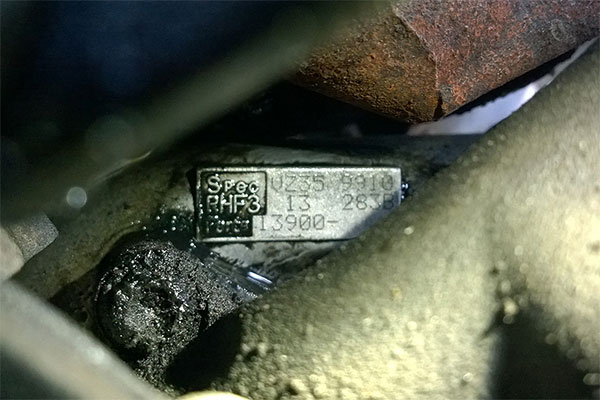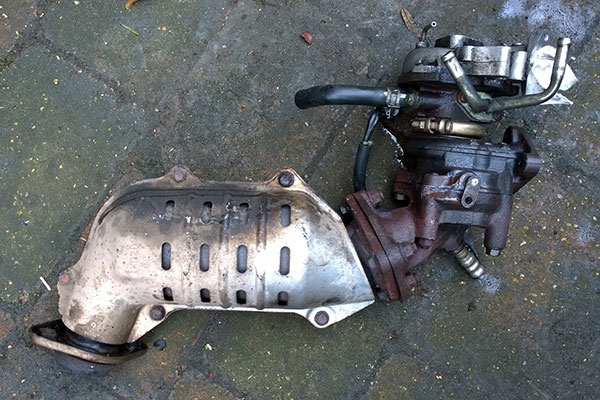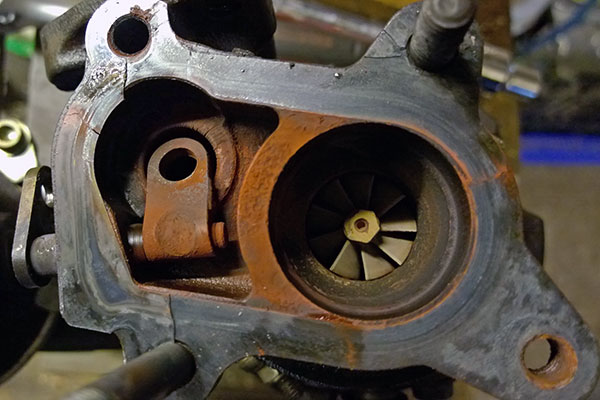What looked at first to be a sticking wastegate actuator turned out to be much more serious… and complicated, once a set of non-standard part numbers were thrown into the mix as well.
The issue began with increasingly regular boost spikes under heavy load, and through a process of elimination an issue with the wastegate seemed to be the most likely. The wastegate actuator rod had been lubricated in the past (something you’re not supposed to do) which led me to think that the actuator might have been a problem previously, but the movement seemed OK and there was plenty of tension in the spring. Unfortunately after checking this on the car I went out for a test drive and couldn’t get boost at all – not good.
Still assuming the wastegate actuator was faulty I hopped on the net to try and find a replacement and immediately ran into issues. The turbo housing identified the turbo on the car as an IHI RHF3 VZ35, but I couldn’t find references to VZ35s being fitted to JB23Ws. Reverting to the Suzuki part number I discovered that only the first, very generic, portion of the number had been stamped on the housing – no help at all and certainly not how you’d expect it to leave the factory either. Next I headed over to megazip’s Suzuki parts fiche to find out what the part number should be so that I could finally start looking for a new actuator… and discovered that whilst some early JB23Ws were fitted with IHI turbos, the part number for my particular car specified a Hitachi HD06 turbo instead. Right…

With replacement actuators of any kind quite hard to find – and with no guarantee they’d fit or solve the issue anyway – I decided to go all out and find a HD06 to return the car to stock. I picked up a low mileage second-hand turbo on Yahoo Auctions Japan – via Jesse Streeter, super-helpful as always – and crossed my fingers and toes that all the inlets, outlets and oil & coolant lines would match up when it arrived.
Removing the old IHI turbo was amazingly straightforward thanks to the spaciousness of the Jimny’s engine bay, the only difficult fixings to reach being those connecting the turbo to the outlet collector. Tracking the exhaust back out of the engine bay it looked easier to unbolt the exhaust mid-pipe from the catalytic converter and bring the turbo, collector and cat out through the engine bay – it was certainly a little tight, but worked well and made it possible to separate the turbo and outlet on the bench instead.

With the outlet removed there was no doubt as to the cause of the problem – a non-existant wastegate was bypassing more than enough exhaust to stop the IHI from ever building boost and no actuator was going to be able to fix that!

With my desire to go back to the correct turbo now more than justified the HD06 was bolted up to the collector and the whole lot snaked back into the engine bay. Everything connected up as before except for the cooling pipe flange which turned out to be incompatible with the new HD06. The fix – at least until I have an answer from Suzuki as to whether it’s possible to order a replacement part – involved fabricating a new flange and re-brazing the pipes from one flange to the other.
Firing the car up was pretty nerve-wracking but there were no leaks, no loose connections and no plumes of smoke from the turbo – success! As the car was off the road for almost 6 weeks it’s hard to draw comparisons between the IHI and the Hitachi but on familiar roads it feels as though the new turbo might spool a little more quickly. It certainly pulls strongly, peaking at 14.1psi under particularly sustained, heavy load – enough to make me consider whether it’s worth chasing the N1’s higher boost threshold mentioned in the previous post. With only another 1.5psi available perhaps it’s more pragmatic to give a 100,000+ mile engine a little breathing room…